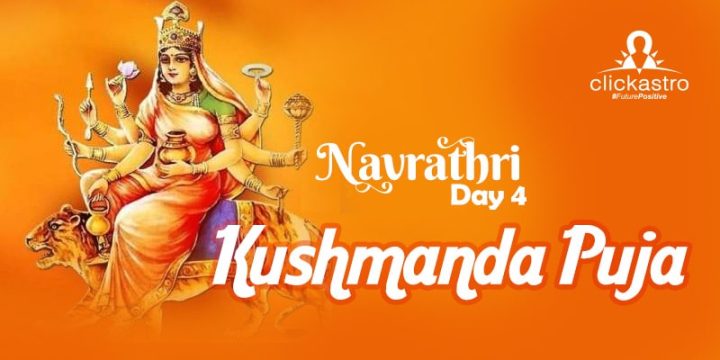Contents[hide]
Read Navratri Day 3 – Chandraghanta Puja
The 4th day of Navratri is dedicated to the reverence of Goddess Kushmanda, the fourth form of the Nava Durga. Kushmanda is derived from the words ‘Ku’, which implies little, ‘Ushma,’ which implies energy, and ‘Anda,’ which implies cosmic egg. It is believed that the Goddess can end the darkness with her divine smile, and the entire universe is represented as a cosmic egg. Goddess Kushmanda is also known as Ashtabhuja Devi as she has eight hands. Assuming the form of Siddhidatri, Goddess Parvati began residing in the centre of the Sun releasing energy into the universe. Since then, the goddess has been referred to as Kushmanda. Kushmanda is the goddess who possesses the capacity and strength to live in the sun. Her body possesses illuminance and vitality that are as bright as that of the sun and possesses healing powers. Goddess Kushmanda is considered to provide the sun direction and energy, which is why the Sun is governed by Goddess Kushmanda. Goddess Siddhidatri is illustrated seated on a lioness and having eight hands. She holds the Kamandal (sacred water pot), bow, Bada, and lotus in her right hand, and Amrit Kalash, Jap Mala, Gada, and Chakra in her left. It is believed that her Jap Mala encompasses all of the energy that bestows the Siddhis and Niddhis. The Hindu scriptures mention that Goddess Siddhidatri created the entire universe, known as Brahmanda in Sanskrit, by revealing a small portion of her smile. She also appreciates Bali of the white pumpkin known as Kushmanda and hence derives the popular name of Goddess Kushmanda.The story of Goddess Kushmanda
Goddess Kushmanda is an incarnation of Durga who is revered on the fourth day of Navratri. Goddess Kushmanda is also renowned as the smiling goddess. The universe is considered to have been created by Goddess Kushmanda. In the beginning, when there was nothing but darkness, Goddess Kushmanda used her energy to create a small cosmic egg, which is the universe in which we now exist. The scriptures state that Goddess Kushmanda dwells in the core of the sun and provides the sun its direction. She is the source of all warmth and energy in the universe. In the beginning when there was nothing, Goddess Kushmanda created the universe and along with that she created three life forms. The first was a fierce Goddess known as Goddess Mahakali who emerged from the left eye. Goddess Mahalakshmi emerged from the third eye from her forehead. From Goddess Kushmanda’s right eye emerged the benevolent and smiling goddess Mahasaraswati. Having created these three life forms, Goddess Kushmanda glanced at them one by one. The first three life forms on Earth were Mahalaxmi, Mahakali, and Mahasaraswati. Goddess Kushmanda glanced at Mahakali from whom a male and female were born. The male possessed five heads and ten arms. The goddess named him Shiva. The female had one head and four arms and was named Saraswati. Next, Goddess Kushmanda looked at Mahalakshmi from whom again a male and a female were born. The male had 4 heads and 4 arms and was named Brahma by the goddess. The female was named Lakshmi who possessed one head and four arms. Finally, Goddess Kushmanda looked at Mahasaraswati from whom a male and a female were born too. The male possessed one head and four arms and was named Vishnu while the female that also possessed one head and four arms was named Shakti. Goddess Kushmanda then gave Shakti to Shiva, Saraswati to Brahma and Lakshmi to Vishnu as their consorts. The three then went on to create the remainder of the universe. The three were later reincorporated again into Goddess Kushmanda. Mahakali, Mahasaraswati, and Mahalaxmi were all absorbed back into the goddess. From then on, she is believed to have become one with Shakti as an orb of energy and form. Therefore, it is believed that Goddess Kushmanda is the one who provides warmth and energy to the entire universe.Kushmanda Puja Vidhi
On the fourth day (Chaturthi Tithi) of Navratri devotees offer prayers to Goddess Kushmanda after offering prayers to the Kalash. Green is considered to be an auspicious colour to be used for the asana. The goddess is offered water and flowers and blessings are sought for good health for the worshipper and their dear ones. This puja is especially fruitful for those who are terminally ill as this puja helps to seek blessing from the goddess for their early recovery. The devotees then offer flowers, dhoop, incense, sandalwood, etc. to the goddess. A bhog of fruits is then offered. This can be made according to the capability of the worshipper. An aarti is then performed for the goddess and the katha is recited. The elders of the house are then paid reverence and prasad is distributed among the devotees.Significance of Kushmanda Puja
It is believed that by worshipping Goddess Kushmanda during Navratri festival helps in alleviating all obstacles from the lives of her devotees. Kushmanda puja bestows good health, wealth, and strength to the devotees. The goddess’ Jap Mala is said to contain all of the power that confer Siddhis and Niddhis. Worshiping Goddess Kushmanda on Navratri endows extreme power and vitality to devotees.Kushmanda Mantra
Om Devi Kushmandayai Namah॥Kushmanda Prarthana:
Surasampurna Kalasham Rudhiraplutameva Cha।Dadhana Hastapadmabhyam Kushmanda Shubhadastu Mey॥
Kushmanda Stuti:
Ya Devi Sarvabhuteshu Goddess Kushmanda Rupena Samsthita।Namastasyai Namastasyai Namastasyai Namo Namaha॥
Dhyana
Vande Vanchhita Kamarthe Chandrardhakritashekharam।Simharudha Ashtabhuja Kushmanda Yashasvineem॥
Bhaswara Bhanu Nibham Anahata Sthitam Chaturtha Durga Trinetram।
Kamandalu, Chapa, Bana, Padma, Sudhakalasha, Chakra, Gada, Japawatidharam॥
Patambara Paridhanam Kamaneeyam Mriduhasya Nanalankara Bhushitam।
Manjira, Hara, Keyura, Kinkini, Ratnakundala, Manditam॥
Praphulla Vadanamcharu Chibukam Kanta Kapolam Tugam Kucham।
Komalangi Smeramukhi Shreekanti Nimnabhi Nitambanim॥
Kushmanda Stotra
Durgatinashini Tvamhi Daridradi Vinashaneem।Jayamda Dhanada Kushmande Pranamamyaham॥
Jagatamata Jagatakatri Jagadadhara Rupaneem।
Charachareshwari Kushmande Pranamamyaham॥
Trailokyasundari Tvamhi Duhkha Shoka Nivarineem।
Paramanandamayi, Kushmande Pranamamyaham॥
Read about Navratri Day 5: Durga Panchami or Lalitha Panchami







